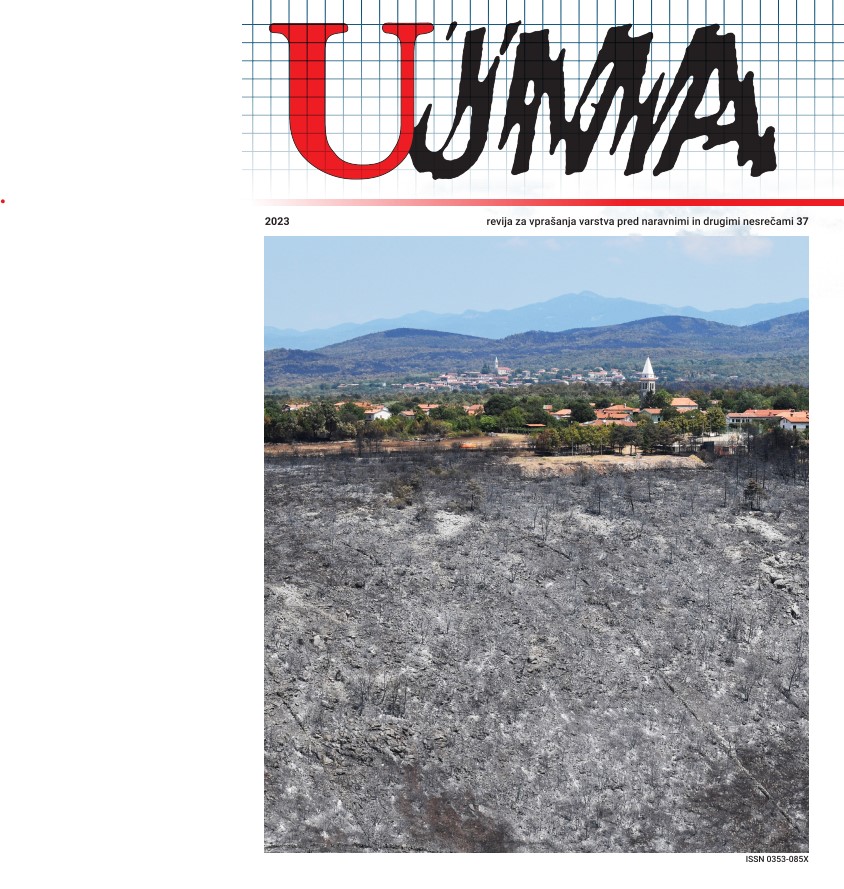CLIMATIC CONDITIONS IN SLOVENIA IN 2022
Abstract
At the national level, 2022 was 1.8°C warmer than the average of the period 1981-2010, and the warmest year ever. The temperature anomaly was mostly between 1.5 and 2°C; it was slightly lower at the stations in the north-east of Slovenia and in Rateče. At some sites in western and central Slovenia the anomaly slightly exceeded 2°C. Only two months were colder than the average of the period 1981-2010, namely March and April, and the average temperature in September was equal to the long-term average. The third warmest June so far, which was 3.7°C warmer than normal, and October, with an anomaly of 3.3°C, stood out. All four seasons were warmer than the average of the period 1981-2010. At the national level, 86% of the average precipitation in the period 1981-2010 fell. The precipitation was less than usual in the vast majority of the country, but there were also a few sites where the precipitation exceeded the average of the period 1981-2010, especially in Bela Krajina. In most of the territory, there was a precipitation deficit of up to 20%. There was a larger deficit in some places in western and northern Slovenia, and in part of the Notranjska region. Only autumn was wetter than normal. March stood out as the driest month of 2022. At the national level, there was 14% more sunny weather than the average of the period 1981-2010. In the vast majority of Slovenia, the average was exceeded by 10 to 20%. At Kredarica, the snow cover on May 2 was 245cm deep. Modest snow cover was also reported in the lowlands.
References
Agencija RS za okolje, 2019. https://meteo.arso.gov.si/uploads/probase/www/climate/text/sl/publications/OPS21_povzetek_posodobljeno.pdf (15. maj 2023).
Agencija RS za okolje, 2022. Mesečni bilten Agencije RS za okolje Naše okolje, št. 1–12, leto 2022. www.arso.gov.si/o%20agenciji/knjižnica/mesečni%20bilten/bilten2022.htm (15. maj 2023).
Agencija RS za okolje, Arhiv meteoroloških podatkov Agencije RS za okolje. http://meteo.arso.gov.si/met/sl/archive/ (15. maj 2023).
Bertalanič, R., 2023. Prehod na novo podnebno primerjalno obdobje 1991–2020, Naše okolje, št. 1, letnik 2023, 3–10.
Cegnar, T., 2015. Podnebne razmere v Sloveniji leta 2014. Ujma, 29, 22–34.
Cegnar, T., 2018. Podnebne razmere v Sloveniji leta 2017. Ujma, 32, 22–36.
Cegnar, T., 2014. Podnebne razmere v Sloveniji leta 2013. Ujma, 28, 20–30.
Cegnar, T., 2016. Podnebne razmere v Sloveniji leta 2015. Ujma, 30, 18–29.
Cegnar, T., 2017. Podnebne razmere v Sloveniji leta 2016. Ujma, 31, 16–28.
Cegnar, T., 2019. Podnebne razmere v Sloveniji leta 2018. Ujma, 33, 24–39.
Cegnar, T., 2021. Podnebne razmere v Sloveniji v letih 2019 in 2020. Ujma, 34–35, 34–61.
Cegnar, T., 2022. Podnebne razmere v Sloveniji leta 2021. Ujma, 36, 31–54.
European Uninon, 2021, Eurobarometer. https://europa.eu/eurobarometer/surveys/detail/2273 (20. junij 2023).
Greenpeace, 2023, Climate Change. www.greenpeace.org.uk/challenges/climate-change/ (20. junij 2023).
Heat shield. https://www.heat-shield.eu/_files/ugd/441f54_3687cbe09bcf4b64add89dc2d8027cf3.pdf (20. junij 2023).
Skynews, António Guterres, 2023: United Nations chief calls for immediate global action to avert climate ‚catastrophe‘. https://news.sky.com/video/antonio-guterres-united-nations-chief-calls-for-immediate-global-action-to-avert-climate-catastrophe-12903316 (20. junij 2023).
World meteorological organization, 2023, State of the Global Climate, 2022. https://public.wmo.int/en/our-mandate/climate/wmo-statement-state-of-global-climate (5. junij 2023).
World meteorological organization, Guide to Climatological Practices, 2018 edition. http://www.wmo.int/pages/prog/wcp/ccl/guide/guide_climat_practices.php (15. maj 2023).
Downloads
Published
Issue
Section
License

This work is licensed under a Creative Commons Attribution-NonCommercial-NoDerivatives 4.0 International License.
The articles are made available to the public under Creative Commons Attribution-NonCommercial-NoDerivatives 4.0 International (CC BY-NC-ND 4.0).


